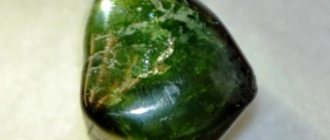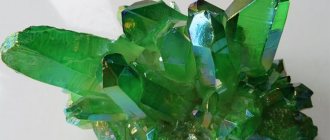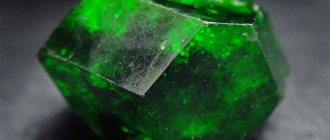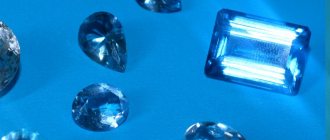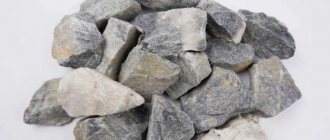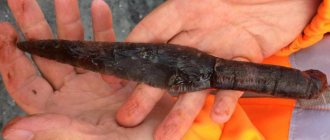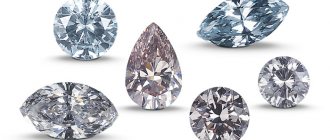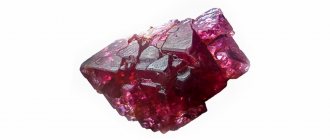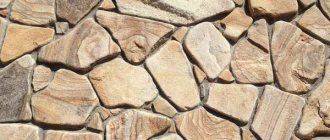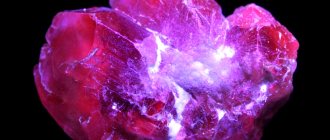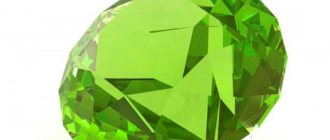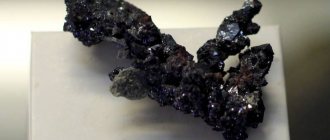Hello, dear readers! The emerald stone has been a valuable acquisition for people since ancient times. From ancient times to the present day, myths and legends have been written about this gem; it is believed to have magical powers and is a symbol of wisdom and hope. From a geological point of view, the nugget belongs to the group of beryls, which have all sorts of shades of green. Due to the fact that the stone is not found in nature as often as, for example, a diamond, the cost of some specimens is several times higher than the price of diamonds.
Description of the emerald
Photos of this gem are fascinating, but none of them can convey the beauty of a natural stone that you can hold in your hands. The word “emerald” originates from Semitic and is translated as “to shine.” The gem is also sometimes called “green ice”. When it comes to what makes an emerald green, the color of the stone depends on the amount of chromium it contains; some varieties of crystals also contain vanadium.
Experts evaluate emerald according to the following parameters:
- Transparency;
- Color;
- Purity;
- Strength.
The gem is one of the most expensive stones and is classified as precious as diamond, sapphire and ruby. Collectors prefer to purchase stones with high levels of purity, transparency, strength, without pronounced defects and a large number of inclusions.
Emerald mines today are located all over the world, including in Colombia, Russia, the USA, Brazil, Spain, South Africa, Egypt, France, Somalia, Zambia, Italy, Zimbabwe, Madagascar and many other countries. Gems from Colombia and Zambia are in particular demand, as they are distinguished by high standards of purity, transparency and have rich, deep shades.
When purchasing a nugget or jewelry with it, it is important not to come across a fake; due to the fact that the stone has a high cost, many enterprising businessmen seek to sell tourmalines, alexandrites, yellow peridots, hydrothermal emeralds, rhinestones and even glass at its price. The authenticity of an emerald can be determined by the following characteristics:
- Real gems are a rich shade of green.
- The stone can withstand temperatures up to 700 degrees, and then its natural color is lost.
- Emerald is quite durable compared to, for example, fake glass or rhinestones.
- The nugget is afraid of sunlight and loses its color under it.
- A genuine copy necessarily has various inclusions in its structure.
Natural stones are also distinguished by their transparent deep shade. It is also worth understanding that, when you see a ring or some other piece of jewelry with a fairly large, beautiful emerald at an affordable price on the counter of a jewelry store, hoping that the stone will not be artificially grown is in vain.
Emerald - the absolute happiness
I hold an emerald in my hand, a beautiful one. He throws sparks and pierces Zarya. It contains the power and grandeur of shades and tones. It contains the daring of the earth and the dream of prophetic dreams. He draws people closer to himself like a magnet. He stirs up discord like a beast. Only the wise can calm its heat. And only to him will he give all his gift.
Smolin P.
Famous specimens Hooker Emerald The stone is fixed in the center of a brooch made of platinum, on which 109 small round diamonds of different sizes are placed in strict symmetry.
One of the world's finest emeralds is the Hooker Emerald, a 75.47 carat emerald cut square gemstone.
The stone has a deep grassy green color, characteristic of emeralds, of high purity and transparency. The emerald was found in the Muzo region (Colombia, Eastern Cordillera), probably in the second half of the 19th century. After being cut in the West, the emerald was acquired by the ruling clan of the Ottoman Empire. The emerald belonged to the Turkish Sultan Abdul Hamid II (1876-1909) and adorned the buckle of his belt. In 1908, with the connivance of the Sultan, the emerald, along with other jewelry, was smuggled from Turkey to Paris and there it was bought by Salomon Habib, then by the jeweler Rosenau and, finally, by Pierre Cartier, who set it into a brooch made of platinum and diamonds and sold this brooch to 1911 to US aristocrat Evelyn Walsh. Finally, in 1955, the Hooker Emerald Brooch was sold to Janet Annenberg Hooker, but the purchase price for the brooch was not disclosed. 22 years later, in 1977, Mrs. Janet Annenberg Hooker donated the "Hooker Emerald Brooch" to the Smithsonian Institution's National Museum of Natural History. Since then, the emerald began to bear her name (Hooker). McKay's Emerald
This is a huge emerald (168 carats) embedded in a platinum pendant.
In 1931, Clarence McKay gave the necklace as a wedding gift to his wife. Since then, the stone has been called the “McKay Emerald” “Mughal” Emerald
Since it is believed that the emerald is associated with Higher matters, Indian emeralds were engraved with sacred texts and ornaments.
One of these emeralds, found in 1695, is called “Mogol Emerald”. The Mogul emerald weighs 217.8 carats and measures 5 x 3.8 x 3.5 cm. Skilled craftsmen applied five lines of prayer to the surface of the stone on one side and a beautiful floral pattern on the other. Special protrusions were made on all sides of the flat stone for attaching it to a turban or other clothing. The Mogul, found in 1695, is one of the most famous Colombian emeralds. Brought uncut to India by the Spaniards, the emerald was soon sold for gold to Muslims from the empire of Genghis Khan. This magnificent emerald belonged to the son of Shah Jahan, the Great Mogul Aurangz :). In 2001, this stone was sold at Christie's in London. The buyer who paid a round sum of $2.2 million for the emerald chose to remain anonymous. Emerald Buddha
Weight 3600 carats, found in 1994 in Madagascar.
Subsequently, a statuette of Buddha was carved on it and called the “Emerald Buddha” in honor of the temple of the same name in Thailand. Emerald “President”
Found in 1993 at the Malyshevsky mine in the Sverdlovsk region, weight about 1200 grams.
It received its name in honor of the first President of Russia Boris Yeltsin. Located in the Diamond Fund, which purchased the emerald for 150 thousand dollars. The President emerald is considered “explosive”, that is, after some time, due to internal stresses in the crystal, it can disintegrate into several parts. “Devonshire Emerald”
Another celebrity - the “Devonshire Emerald”, lush green in color, was mined in the famous Muso mines in South America, had the shape of a hexagonal prism measuring 5 cm in diameter and the same in height.
It weighed 1,384 carats (304 g). For a long time, this emerald belonged to the Emperor of Brazil, Pedro I. In 1831, Pedro I, after abdicating the throne, came to Europe and presented an emerald crystal to the Duke of Devonshire. Since that time, this crystal appears in all world registries as the “Devonshire emerald”. “Kokovinsky” emerald
“Kokovinsky” emerald” - Found in the spring of 1833 in the Urals, and named after the famous Ural stone cutter Kokovin.
Weighs about 400 grams and is stored in the Mineralogical Museum. Fersman. In Moscow. Emeralds by Elizabeth Taylor Elizabeth Taylor
The emerald set from “BVLGARI” was presented by Richard Burton after another reconciliation between the spouses) Elizabeth Taylor at the Oscars for the film “Who’s Afraid of Virginia Woolf” in 1967. And Richard Burton bought this set of emeralds from Bulgari in Italy for Elizabeth during the filming of Cleopatra.
Elizabeth Taylor loved emeralds; she and Barton bought these earrings in Italy, and the actress is pictured in 2007.
Ring with an obscenely huge emerald - a gift from V. Doronin
Angelina Jolie at the Oscars in 2009.
That day, Angelina chose a set with emeralds from Lorraine Schwarz. By the way, this summer Angelina presented a new jewelry collection called The Style of Jolie and created in partnership with jeweler Robert Prokop.
Emeralds also occupy a worthy place in the collection) Royal emeralds Tiara of Grand Duchess Maria Pavlovna (Famous Vladimir Tiara)
Currently belongs to Queen Elizabeth II.
Often the pearls in it are replaced with Cambridge emeralds from Mary of Teck. Elizabeth II in her favorite emeralds Emerald parure of Empress Josephine
The parure, decorated with dark juicy emeralds, is made in the neoclassical style of the Napoleonic era, and their first owner was Empress Josephine, and now these jewelry, having changed several owners, belong to the Norwegian Queen Sonja.
Jordan Emerald Wreath Tiara
During her state visit to Sweden in 2000, Queen Rania of Jordan wore an emerald wreath tiara from the jewelry house Boucheron.
The most expensive tiara in the world
A dazzling emerald tiara sold for a record $12.8 million to an anonymous buyer at Sotheby's.
The tiara was created by Chaumet craftsmen at the request of the Prince of Germany, Guido Henckel von Donnersmarck, and was custom-made for his second wife Katharina. Strictly speaking, it is difficult to find a royal house in the world that does not have stunningly beautiful emeralds in its treasuries, which could tell us an interesting story spanning several centuries. If gossipers want to, you can make a post about royal emeralds, since there is a lot of information on this topic and it deserves special attention. Therefore, here we will limit ourselves to a couple of such treasures. A little history
The exact date of the “birth” of emerald is unknown, but this beautiful dense green gem with a bluish tint never went out of fashion, and in the history of ancient civilizations we find references to emeralds. In the Bible, emerald is one of the twelve stones on the breastplate of the Jewish high priest. In Muslim legends, paradise is a beautiful garden strewn with emeralds. The stone was already popular in Ancient Egypt, where the very first emerald mines were located - the Egyptians believed that its green color symbolized eternal youth and endless life, and the famous Queen Cleopatra inlaid furniture and even doors with emeralds, and adorned her fingers with emerald rings, one of which, the color grape leaf, considered it her love talisman. According to some data, as a sign of special favor, Cleopatra presented close nobles with her image engraved on an emerald. There is a biblical legend according to which, when Lucifer was expelled from paradise, one emerald fell from his head. This stone was used to make the cup that the Queen of Sheba gave to King Solomon. This cup was used by Christ at the Last Supper. After the crucifixion of Christ, Joseph of Arimathea collected his blood in a cup. This cup is known to everyone as the “Holy Grail”; whoever drinks from it receives forgiveness of sins, eternal life, etc. The Romans and Greeks were very fond of emeralds, which they called “emeralds”; they often carved gems on them; Pliny and Herodotus spoke highly of emeralds, and Emperor Nero owned a large convex emerald through which he watched gladiator battles. The Great Mogul, the legendary Indian ruler whose wealth was the stuff of legend and was expressed mainly in huge swathes of jewelry, wore a 218-carat emerald on his turban, on which was engraved a sacred text. When the Spaniards arrived in South America, the first thing they noticed was gold and a huge amount of emeralds, which were mined in abundance in local mines - the five selected emeralds that Fernando Cortes brought as a gift to his niece, bypassing the queen who dreamed of them, were especially famous Isabella; each of them had a bizarre shape - one had the shape of a rose, the second a fish with golden eyes, the third - horns, the fourth was carved in the form of a bell with a pearl instead of a tongue, and the fifth was carved in the shape of a goblet with a foot of gold. The Indians of Peru had an emerald the size of an ostrich egg, weighing about 3 kg, which they worshiped as the embodiment of the goddess Umina, sacrificing scatterings of smaller stones - the conquistadors tried for a long time to find this “mother of the emerald,” but they never found it. Ancient people attributed many healing and even magical properties to emerald. So, in a Czech book of the 14th century. it was claimed that the emerald was found in the griffin's nest! The property of emerald is to detect betrayal. This was even elevated to myth: according to legend, when the Hungarian king Bela IV hugged his wife without removing the ring with a huge emerald from his finger, the stone immediately split into three parts.
Epiphanius claimed that this gem was able to predict the future, and ancient Armenian manuscripts said that snakes go blind at the sight of emeralds, and with its help a person can survive a snake or scorpion bite. All authors agreed that emerald “cools the mind,” makes its owner more honest and righteous, and brings wisdom - perhaps these were the qualities that A. S. Pushkin valued in his favorite emerald ring.
And in the old days, thieves avoided emeralds - it was believed that whoever stole this stone - a symbol of spiritual purity - would bitterly repent.
Magical properties
Modern lithotherapists consider emerald the main medicine for the eyes: its pure green color really relieves eye strain.
In addition, emerald saves from insomnia and nightmares, normalizes the state of mind and calms the nerves, and relieves chronic fatigue syndrome. If you put an emerald in a glass of raw water, you can drink it without boiling - the stone has antibacterial properties, such water treats stomach and bladder inflammation, stabilizes blood pressure. The wearer of jewelry with an emerald gradually improves the functioning of all body systems, stabilizes metabolism, strengthens the heart muscle; emerald rejuvenates and multiplies the years of life of its owner. Without any conventions, emerald can be called a talisman of absolute happiness, good luck and prosperity in all areas of life. This green stone brings material well-being and success in business to the life of its owner, helping in business negotiations; for those who seek recognition in creativity, emerald will bring inspiration, fame, and public attention; Emerald will help scientists and researchers gain wisdom, improve memory and understanding. The stone also works great with those who have devoted themselves to the spiritual path: it reveals to them the secrets of the Universe, introduces heavenly revelations, and sharpens intuition. Traditionally, emerald is a protector both at home and on a long journey, on land and at sea. For those looking for love, emerald attracts happy long-term relationships, protects against betrayal, increases female attractiveness and male strength. And the emerald, as it were, gives silent advice to everyone, without exception, being a direct “conductor” between a person and the Higher Mind. Purchasing
When purchasing emeralds, keep in mind that the estimated value of the gemstones depends on their size, color, clarity and cut (although due to the common susceptibility of emerald to contain foreign inclusions, a fairly low degree of clarity of an emerald is considered quite acceptable as long as light penetrates the stone ).
The main distinguishing feature of emerald is its color. There are five groups of emeralds based on color characteristics: dark green, normal green, medium green, light green and light with a greenish tint. All of these colors are popular in jewelry making. And if you take a stone that has approximately the same transparency, the presence of cracks or inclusions, its cost will increase depending on the intensity of the color of the stone. The more saturated the color of the stone, the higher the cost of the product. The difference between the cost of different shades of green in an emerald can vary greatly:) A large emerald weight is rare, as stones that are mostly found are small in weight. Therefore, the main value in emerald is its transparency, color and brilliance. An emerald weighing up to 0.49 carats is considered small, medium up to 1 carat, large over one carat, very large ones weighing more than 10 carats. Let's try to find out how to recognize a natural emerald.
Often, cheaper beryls, artificial stones grown in a laboratory, or even ordinary glass rhinestones are sold under the guise of expensive and valuable natural emeralds.
Sometimes they are difficult to distinguish, but real emeralds are less bright and shiny, they are more like green velvet, from which you cannot take your eyes off. For our research, you will need a magnifying glass, a glass of water and, in fact, an emerald. 1.
If an emerald is set, it is very difficult to distinguish artificial from natural.
First of all, you need to focus on price. A real stone should be expensive, but large emeralds are incredibly expensive. Therefore, if you see a ring with a large stone at a similar price in a store, be on your guard: it is probably a fake. Large stones that are too shiny are most likely ordinary glass jewelry. 2.
The more transparent the emerald, the higher its value.
Muddy ones don’t look as attractive, but the chances that the stones are real are much greater. Emeralds come in both light and dark. Among the light ones, clean and transparent ones come across quite often. If you purchase a necklace or earrings from a reputable store, there is much less danger of running into a fake. Dark emeralds are much more expensive and can only be purchased in high-end jewelry boutiques. 3.
Determining the authenticity of a stone without a setting is not so difficult.
Take a good magnifying glass and look at the emerald from an angle. From this angle you can see the so-called growth lines of the stone. For an artificial emerald grown in a laboratory, these lines will be absolutely parallel. In a real stone, the lines should also be parallel, but not in such an orderly manner. 4.
When choosing a stone for a ring or pendant, you should pay attention to the color, and not the purity of the emerald.
Experts say that the best dark emeralds should appear from a distance like pieces of green soft velvet, but such an emerald costs about 6,000 euros per carat. It is better to choose a stone of a dark shade, even if it has a blue or yellow tint and inclusions inside. The presence of defects in the form of cracks, opaque places and uneven coloring is precisely the key to the authenticity of the stone. Natural stones have inclusions in the form of mica crystals and microplates. Very bright stones may actually be beryl, green tourmaline or peridot. 5.
Although bright emeralds are more valued, it is when choosing them that it is easy to run into a synthetic analogue.
Such stones have a very rich color, often with a blue tint, although emeralds from Colombia can also be like this. Synthetic stones grown hydrothermally have gaseous or liquid inclusions. In fact, these are not jewelry beryls that are covered with a layer of artificial emerald. These are pale green stones with a lot of cracks, which when immersed in water become like a bright green outline. An outright fake, if you put it in a glass of water and look at it from above, it will turn out to be reddish. If it is really important for you to know whether you have an emerald or not, and what kind it is, you cannot do without visiting a gemological center, not a jeweler. Not every jeweler can tell you something intelligible. Gemologists can also be found at gem exhibitions. Care
Like most gemstones available for sale today, emeralds require some care to clear the stone's surface imperfections and improve its color.
The most common (and acceptable) technique is to coat the emerald with a green-tinged oil that fills in surface cracks. The oil gives the emerald strength and makes it more resistant to damage, as well as improving its green color. When caring for your emerald, avoid ultrasonic cleaners, which can remove oil, or harsh detergents, which can damage the emerald's relatively soft surface. Emeralds should be cleaned with a soft, damp cloth and warm water and, if necessary, a soft-bristled brush. Emerald is known to crack easily due to sudden changes in temperature, which should be taken into account when wearing it. Regularly check the integrity of the teeth of the setting - the stone in the setting should not “lobble”, and, if possible, have it re-oiled in a jewelry workshop every few years. Emerald belongs to the category of stones that are inherited, then it gives its owner help, support and clarification in confusing situations, and this rare mineral should be worn on the little finger so that it becomes a talisman. After all, high quality natural emeralds are very rare, so their value is high and is estimated at around £10,000 per carat (0.2 grams), and stones with historical value or emerald jewelry are much more expensive. Famous jewelry houses Earrings with emeralds, diamonds and onyx, Sortilège de Cartier, Cartier. Ring and bracelet with emeralds, Temple St. Claire
Harry Winston necklace and ring, diamonds, emeralds.
Brooch Van Cleef & Arpels, Héloïse, Ballet Précieux collection, diamonds, emeralds. Piaget ring with emeralds
Brooch with emeralds Van Cleef & Arpels Apple Ring, Choprad Necklace and earrings, Haute Joaillerie, Boucheron Gold bracelet “A scattering of stones”, Butani Necklace and bracelet, Cartier
and a little more)
“Real” jewelry Handmade necklace, author Mikhailova Natalya Silver earrings with emeralds and zircons, 4300 rub. Pendant with emerald, RUB 5,990. Silver bracelet with emeralds, 8650 rub. Pendant with natural emeralds, about 19,000 rubles. Ring with emerald, 5500 rub. Handmade beads, author Svetlana Savina, 9200 rub.
And I want to disappoint you, as well as myself, virgins, a little... Those emeralds in products that we see in ordinary jewelry stores at “human” prices - alas!
most likely not natural (. Other posts from this series
Aquamarine - a symbol of fidelity Tourmaline - a stone of joy, love and victory Alexandrite - a stone of sadness Opal - a rainbow in the hands Good luck to everyone!)
Updated 20/12/12 15:53
: Ring of Alexandra Anastasia Lisowska from the “Magnificent Century”
Types and colors of gems
In fact, it is quite difficult to find the ideal stone in nature; a huge amount of time and effort is spent searching for it; such samples are sold at incredible prices and are rarely cut. The largest and most amazing specimens were found only in Colombia, their color is mostly grassy green. Colombia is called the emerald country for a reason; the minerals mined here have a minimal number of defects and inclusions.
In Russia, these precious stones are mined from mines in the Urals. Ural nugget deposits were discovered in the 19th century. Russian gems are distinguished by a thick green tint, which emphasizes their uniqueness. The color saturation of emerald depends on the amount of iron and chromium in the mineral.
Zambian nuggets are distinguished by high indicators in such criteria as transparency; in addition to green, they can also have a bluish tint. In Zimbabwe, minerals are mined whose colors combine green and yellow. This is very rare, therefore it is also highly valued by experts.
The healing properties of the mineral
Everything that is created by nature has always attracted people; many believed in the miraculous power of stones and their ability to cure diseases. Knowing what an emerald looks like and its meaning, people have always sought to have it in their home or wear jewelry with it.
Today, researchers have come to the conclusion that the stone is indeed capable of normalizing blood pressure, relieving headaches, curing stomach diseases, normalizing joint function, and helping with disorders of the genitourinary system. The mineral is also known to have antimicrobial properties and can purify water, making it drinkable.
Despite the fact that modern people rarely heal with stones and do not particularly believe in the power of the dark green or pale green color of minerals, wearing them as inserts in jewelry certainly will not harm anyone.
Magical and healing properties of emerald
In addition to the beauty that emerald radiates, it is endowed with magical and healing properties. Now you will learn in detail what emerald contains.
Useful magical and healing properties of emerald:
- For many years, it has been believed that the emerald stone helps get rid of various diseases . The stone has a beneficial effect on the bladder, stomach, joints and head.
- Emerald is used to purify water . To do this, it is enough for the mineral to sit in a glass of water for an hour, after which it becomes absolutely clean.
- In ancient times, the stone was used to treat epilepsy. And now many doctors advise wearing Emerald to prevent nightmares.
- It can help with various sleep disorders.
- Emerald is considered an assistant for a person, supporting him in different life situations.
- Emerald is able to educate its owner and prevents him from going astray.
- Products with emerald bring good luck! But only for those who have a positive attitude. This stone can harm evil and two-faced people. Be careful.
- Green stone calms the nervous system, helps the eyes relax and rest.
- Emerald treats diabetes, burns, and helps with fever.
- Useful for insomnia.
- Treats coughs and colds.
- Serves as an excellent talisman for mothers and sailors.
- It is an amulet for pregnant women and newborn children. In ancient times, amulets with emeralds were placed in children's cradles.
- Emerald gives inspiration and bright new ideas to creative people.
- It also helps those who run their own business to catch their luck.
- Emerald is also useful for those engaged in scientific activities.
But it is worth remembering that there is an artificial emerald stone, as many fakes are made. Only natural stone can provide maximum benefit to its owner.
Read on our website: How to distinguish a fake emerald
Many sorcerers used the mineral for their rituals and predicting the future.
Magical properties of the gem
From ancient times to this day, people have believed in the magical powers of precious stones. It is worth looking into history and remembering that monarchs of different states decorated their clothes, rings, necklaces, crowns, bracelets and other items with emeralds. This was done not only because the nugget has extraordinary beauty, but also because many believed in its power against the evil eye and damage.
Also, those who believe in magic claim that emerald can restrain the aggression of its owner, protect him from lies, adventurism, and the tendency to infidelity.
With the help of a stone, you can cleanse your home of evil spells and negativity; it is enough for it to lie overnight in each room in turn.
For people who believe in the miraculous power of the nugget, it promises good luck, success in any endeavor, a favorable atmosphere in the family, and protects against bad energy.
Sometimes emerald is called the stone of death due to the fact that strong psychics can use it to receive signals from dead people and establish contact with them.
The meaning of the stone for a particular zodiac sign is also important; according to the horoscope, the mineral is not suitable for all people.
The area of magic includes questions about what green beryl is dreamed about and what its appearance in a dream means. As a rule, a gem in a dream promises the approach of something very pleasant and good; dreams with it do not foretell trouble.
Which zodiac sign does Emaragd suit?
It is very important to know whose stone is contraindicated by zodiac sign and who is contraindicated to wear it; it is believed that emerald affects people according to the horoscope as follows:
- Aries promises to give success in business meetings;
- Provide Taurus with enough energy;
- For Gemini, the gem is able to protect them from evil eyes and damage;
- For Cancers, it can help achieve peace of mind and peace;
- For a Leo woman and a Leo man, wearing items with emeralds helps them to be strong;
- For Libra and Virgo, the mineral will help to recover from thyroid diseases and find peace of mind;
- For Scorpios, the stone can help cope with violent emotions and aggression;
- With the help of the gem, Capricorns and Sagittarius will get rid of mental anxieties and gain self-confidence;
- Pisces and Aquarius, thanks to the emerald, will become successful and happy, since it is most favorable to them.
When asked who should wear jewelry with a gem in order to be satisfied with life, it is worth answering that Libra, Aries, Capricorn and Virgo.
Emerald stone: properties, color, types of emerald
Mostly green Emerald is found. There are crystals with six amazing rays. Its price will vary depending on the place of origin and other characteristics. The most valuable stone is considered to be from Colombia; the color of this emerald is grassy.
There are also other colors of emerald. Emerald comes with a yellow tint. There are also transparent minerals, but they still have a green tint. Basically, emerald stone is colored with small cracks, which is why it can easily split.
In terms of their properties, products with emerald are compared with ruby, diamond, and sapphire. The price of an Emerald can exceed the cost of diamonds.
What is hydrothermal emerald?
Having learned that the stone is suitable to one degree or another for all signs of the zodiac, many begin to think about purchasing jewelry with it. Having studied the characteristics of the stone, you can go shopping, but even in this case there is a risk of buying not a natural, but an artificially grown specimen. According to the description of the external characteristics and physical qualities, these two samples are almost identical; it will be very difficult for a non-professional to distinguish a nano emerald from a natural one.
Synthetic gems are created today in laboratories around the world. It is known that nature takes thousands and sometimes millions of years to grow a noble mineral, so it is not surprising that they are very expensive. In a laboratory of decent size, a crystal can be grown in about a month.
To create hydrothermal stone, powder from real nuggets left over from cutting is used, which is placed in an autoclave along with various substances, reactions occur under high pressure and temperatures. The material is then placed in a cold temperature zone to allow the crystallization process to take place.
Synthetic stones are difficult to classify as precious or semi-precious stones, but they are their artificially grown analogues. A hydrothermal gem often differs from a real gem in greater purity, transparency and perfect shade, but, nevertheless, costs tens of times less. Even an opaque, matte or milky emerald with defects, but a natural mineral will cost more than a synthetic one.
Hydrothermal stone is more durable and contains fewer inclusions than natural stone, which look like gaseous bubbles. Also, the synthetic gem is not afraid of high temperatures and exposure to ultraviolet radiation. In addition, it is believed that even artificially grown emerald has magical properties.
Despite all the positive properties of a nugget created artificially, true connoisseurs of precious stones would never prefer it to real green beryl.
Emerald Magic
The emerald gem attracts attention and captivates the eye. It was once considered sacred and even worshiped. It was given as a gift, symbolizing love and fidelity. Science has proven the healing and magical properties of Emerald.
Emerald stone is a type of beryl. The emerald stone contains some trace elements, due to which it turns green. This mineral is valued among many peoples, as it has wonderful magical properties. In our article you will learn everything about the properties of emerald, what color is emerald, who is emerald suitable for, what zodiac signs is it suitable for.
Now Emeralds are used for jewelry. So that love never dies, many lovers gave each other this jewel. Now let's talk in more detail about the properties of the emerald stone.
Stones similar to emeralds
When it is not possible to purchase products with real gems, you can buy them with stones similar to emerald, but cheaper. Today, instead of natural emeralds, special beryl glass is inserted into jewelry, which is tinted with chrome; of course, such jewelry costs the same as with ordinary cubic zirconia.
Fluorite is also very similar to emerald, but it is much softer and has a much weaker shine; to the untrained eye it will be difficult to distinguish it from a real gem. Experts who know everything about the stone will be able to quickly see the difference.
In addition, today in jewelry stores you can buy rings, brooches, and earrings with tourmalines containing chromium. If you ask what color these stones are, the answer will be deep green.
An excellent imitation of a real emerald would be Yakut or chrome dipsides, which would be difficult to distinguish even for a professional without a special device. But, this stone is not so often found in nature, therefore there are quite a few jewelry with it.
If everything is clear with unprocessed nuggets, then it is worth saying that only after cutting, chrysoprase, jadeite, peridot and some types of quartz can easily be confused with a real mineral.
Jewelry products with the above samples have a decent appearance, they look quite beautiful, but still, despite the similarity with emeralds, these stones are different, although they also have their advantages. If you really want jewelry with this gem, but it’s not expensive, then it’s better to buy it with a synthetic mineral, which is a complete analogue of a real emerald.
Emerald: last among the first
Emerald is the last mineral among the highest class of gemstones (on the Mohs scale). The name of this mesmerizing stone comes from the words “zammorod” and “zumundi”, which in Sanskrit and Persian meant “green”, and in Old Church Slavonic emeralds were called “smaragd”. In Rus', emerald was considered a stone of wisdom, composure and hope.
The modern form of the word emerald (emerald) appeared in English only in the 16th century. There is an assumption that initially this was the name given to all green minerals, even such as chrysocolla.
The history of emerald begins with Ancient Egypt. The first deposits appeared off the coast of the Red Sea from 2000 to 1500 BC. These deposits were found at the beginning of the 19th century and were called “Cleopatra’s Mines.” In Egypt it was not only precious, but also a revered stone; it was called “the stone of the mother of the gods Isis.”
Emeralds were also valued in South America. There is a legend about the existence of an emerald, the size of an ostrich egg and weighing about 3 kg, this stone was considered a deity by the ancient Peruvian Indians. But the Spanish conquerors never managed to find it; the stone was securely hidden by the priests of the temple.
In the Indian Vedas, emerald was called a “lucky” stone, “promoting prosperity.” This is probably why crystals of incredible beauty adorned the chests of Indian rulers - maharajas and their wives. In the 16th century, Spanish conquerors found a huge number of emeralds in the treasuries of the Ancient Incas and Aztecs - this time is considered the second birth of the stone.
Emerald is an igneous mineral.
Emerald is of igneous origin and belongs to the beryl family. Emerald is easy to distinguish from other stones of similar color due to its high degree of purity and transparency, as well as its unique shade of green.
Emerald crystals in mica.
Along with diamond and ruby, emerald is one of the most expensive minerals. According to the law “On Currency Regulation” in Russia, this stone is equated to freely convertible currency, that is, it can be exchanged for any foreign currencies, act as payments in international transactions, and also participate in trading on the main foreign exchange markets. Emerald is considered a fairly soft mineral. Therefore, if products with emeralds are stored incorrectly, the stones lose their shine and may become dull.
It's no secret that natural stones have many defects and it is very difficult to find gems in nature that are ideal in purity and shade. Thus, during mining, minerals weighing hundreds of carats are found, but have no jewelry value. Medium-sized minerals are considered the most valuable, with ideal specimens most often found among them. The presence of blue or yellow colors in a stone significantly reduces its value, and rare pure emeralds with a bluish-green color can be more expensive than diamonds.
The most valuable are emeralds, which are called “antique”. These stones have a rich, dark green color, but can only be found in old deposits.
Emerald cut.
Emerald is one of the few stones after which a certain method of cutting minerals was named, which is widespread in jewelry production.
This is a type of step cut, in which the stone is given a rectangular shape with beveled corners. The classic emerald cut is a rectangular shape, but now square emerald cut gemstones are becoming increasingly popular. Thanks to the step cut, the inner color of the stone is revealed in full force. The emerald cut protects even the most fragile minerals from damage and chips, and also advantageously represents the color of the stone and its purity.
Famous emerald deposits.
As you know, the location of stones plays an important role in their evaluation. The best sapphires are considered to be Kashmiri, and the highest quality rubies are Burmese, but Colombian emeralds are recognized as the standard emeralds. For a long time, Colombia has been considered the largest supplier of emeralds. It is in Colombia that the famous Muso mines are located, where the brightest minerals are mined. According to legend, the first Colombian deposits were discovered by the Ancient Incas - one of the local residents showed deposits of emeralds in exchange for a small mirror.
Colombian emerald.
Colombia now accounts for about 90% of the world's emerald production. There are more than 150 deposits of green minerals here. Moreover, the majority of all emerald deposits are in the hands of private companies, and the state participates as a shareholder.
The remaining 10% of production comes from just a few countries around the world. The second place of honor is occupied by Russia (in Russia the Urals are famous for its emerald deposits), followed by several African countries, Pakistan, India and Afghanistan. Colombian emeralds are considered the most valuable, as they are distinguished by a particularly bright green color. Particularly rare emeralds with a cat's eye effect were also found here. Also, emeralds from Zambia, Zimbabwe and Brazil are popular on the world market; the color of stones from these deposits is usually darker with a slight blue tint. Thanks to these deposits, the emerald market is now more diverse.
Interesting facts about emeralds:
— emeralds are very fragile gems. They can crack even from a minor impact;
— the Roman emperor Nero used an emerald as a monocle, through which he watched gladiator fights (the stone was so transparent!). Unfortunately, after the death of the emperor, the stone disappeared without a trace;
- the largest emerald in the world was found in 1974 in Brazil. His weight was 28 kg;
— the largest processed emerald crystal weighs 7.5 kg. It was also found and processed in Brazil, where there are more than 6,000 emerald mines;
The largest emerald.
- the “President” emerald with an original weight of 1200 grams was found in the Urals and was named in honor of Boris Yeltsin;
Emerald "President".
- Of all the precious stones, only emerald crystals were considered by Queen Cleopatra worthy of their beauty. As a sign of special favor, she gave those close to her image carved on an emerald. The Arabian deposit of uzumruds, where thousands of slaves worked, was called “The Mines of Queen Cleopatra.” There are many legends according to which the gems mined there became the most valuable treasures in the collections of many rulers. Thus, the Queen of Sheba was a great lover of emeralds;
- at the beginning of the 16th century, conquistador Fernando Cortes wanted to give his bride five rare emeralds. The minerals were distinguished not only by their unsurpassed quality, but also by their special shapes in the form of a rose, bell, goblet, horn and fish. The Mexican had to steal the stones from the Incas. But Cortés did not know that Queen Isabella of Castile was also hunting for these stones, and she became his mortal enemy. Despite the long pursuit of the emeralds, none of the jewel hunters achieved victory;
— the Hermitage houses a 16th-century Spanish pendant in the form of a cross of five emeralds with a caravel attached to it, the body of which is carved from emerald and weighs about 125 carats;
Caravel pendant.
— in Vienna, the State Collection contains a vase (vessel for cosmetic ointment) 10 cm high, weighing 536 g (2681 carats), carved at the turn of the 16th-17th centuries by the Milanese engraver Dionisio Miseroni from Colombian emerald. It is very likely that this particular vessel served as the prototype for A. Dumas’s bonbonniere of the Count of Monte Cristo, carved from a solid emerald.
A vase for storing cosmetic ointment made of emerald.
Hope you enjoyed it!
Best regards, your Silver_avenue.
